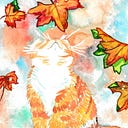Cats in Finnish mythology and folklore
In Finland, there have been cats since the Iron Age. For the past few thousand years, we’ve had the great privilege to enjoy the company of our mysterious feline friends.
In the Middle Ages in Europe during the early witch hunts thousands of cats were burnt and killed because they were considered to be witches animals and sometimes devil’s worshipers in disguise. Witch hunts were a dark mark in the history of mankind. Killing cats lead to lots of troubles such as a massive increase in the rat population and eventually to black death.
This never happened in Finland. Christianity arrived in northern Europe quite late and the first witch hunts took place in Finland and in Sweden in the middle of the 17th century. Which was the time when witch hunts were slowing down in the rest of Europe. Witch hunts were also the time when the idea of “western witch” was first time introduced to Finland and Sweden. Stereotypical witch (usually a woman) who rode a broomstick and owned a black cat. Before the arrival of Christianity and centuries that followed folk magic was extremely common in northern Europe. The traditional idea of a witch was connected to shamanism. Fortunately killing cats never reached to northern Europe. The number of witches killed was also quite small in Finland and Sweden compared to many other countries.
Finland in the past was very much an agricultural society. Cats were seen as very important animals because they killed rats and rodents. Many families kept the so-called lyylieläin which means a domesticated wild animal that lived on the farm but not in the same sense as we have pets nowadays in our homes. People fed these animals and took care of them. It was believed that they brought good luck for the farm and the family. Lyylieläin could be for example a cat or a snake or even a wild deer.
Cats were some of the most popular luck bringer animals. It was believed that an elf tonttu could appear in the shape of a white cat. Also, ghosts and restless spirits could easily take the form of a white cat.
In Finnish pagan practice and mythology idea of a cat being the most popular witch’s animal is a concept that has arrived from other western countries. Finnish pagan tradition was originally shamanistic and most animals connected to shamans were birds. However among several Finnish pagans nowadays you can find many people with cats as their familiar.
In Finnish mythology, every animal and plant species have their own Emuu. Emuu is the parental spirit of the specie.
Of course I know the cat’s origin
The incubation of “grey beard”
On as stone was obtained
the cat with a nose of a girl
with the head of a hare
with a tail of Hiisi’s plait of hair
with the claws of a viper snake
with feet of cloudberries
from a wolf the rest of it’s body comes
This is Finnish pagan birth myth “the Origin of the cat”. What it tells us is that cat’s Emuu was Elf the Grey Beard. He created the cat from several different ingredients and threw them to the stones of the sauna. Cat is related to humans (girls nose), hares (head of a hare), snakes (claws). It also has a tail of Hiisi’s plait of hair. Hiisi in Finnish mythology can refer to a giant but hiisi is also a word used from a pagan worshipping place and sacred places in nature. This can also reflect the wild nature of a cat. The rest of the cat’s body comes from the wolf and if you look at the cat's paws they do look like cloudberries.
The birth of the cat is one of my favourite myths in all Finnish mythology. The idea of a cat being born in the sauna is very fitting for the cat’s nature. The way it’s always trying to find the warmest (and often the quietest) spot in the house. Also the way they always look for those warm spots could it be a subconscious need to look at the warm place where they were born? In shamanism, saunas were used as metaphors for wombs. No wonder in Finn-Ugrian cultures going to the sauna is related to birth, death and transition phases of life.
Another interesting idea behind this myth is the fact that cats were created by an elf. In Finnish mythology, elves are often connected to different buildings. The common myth tells that the first person who took a bath in the sauna became the sauna elf after they passed away. Also, the first person who lived in the house they built became the house elf. Elf in the Finnish context especially means a protector spirit. Some scholars have suggested that maybe this birth myth of the cat tells us how elf simply wanted to create an animal companion to protect the homes and farms with them.
Cats being domesticated animals easily get attached to humans but even more often cats become attached to different places. Finnish mythology and folk poems often are more intertwined to reality than we even realize. Cats are the foremost protective spirits of the home.
If you enjoy reading my content, consider subscribing to my feed. Also, if you are not a Medium member and you would like to gain unlimited access to the platform, consider using my referral link right here to sign up. It’s $5 a month and you get unlimited access to my articles and many others like mine. Thanks
